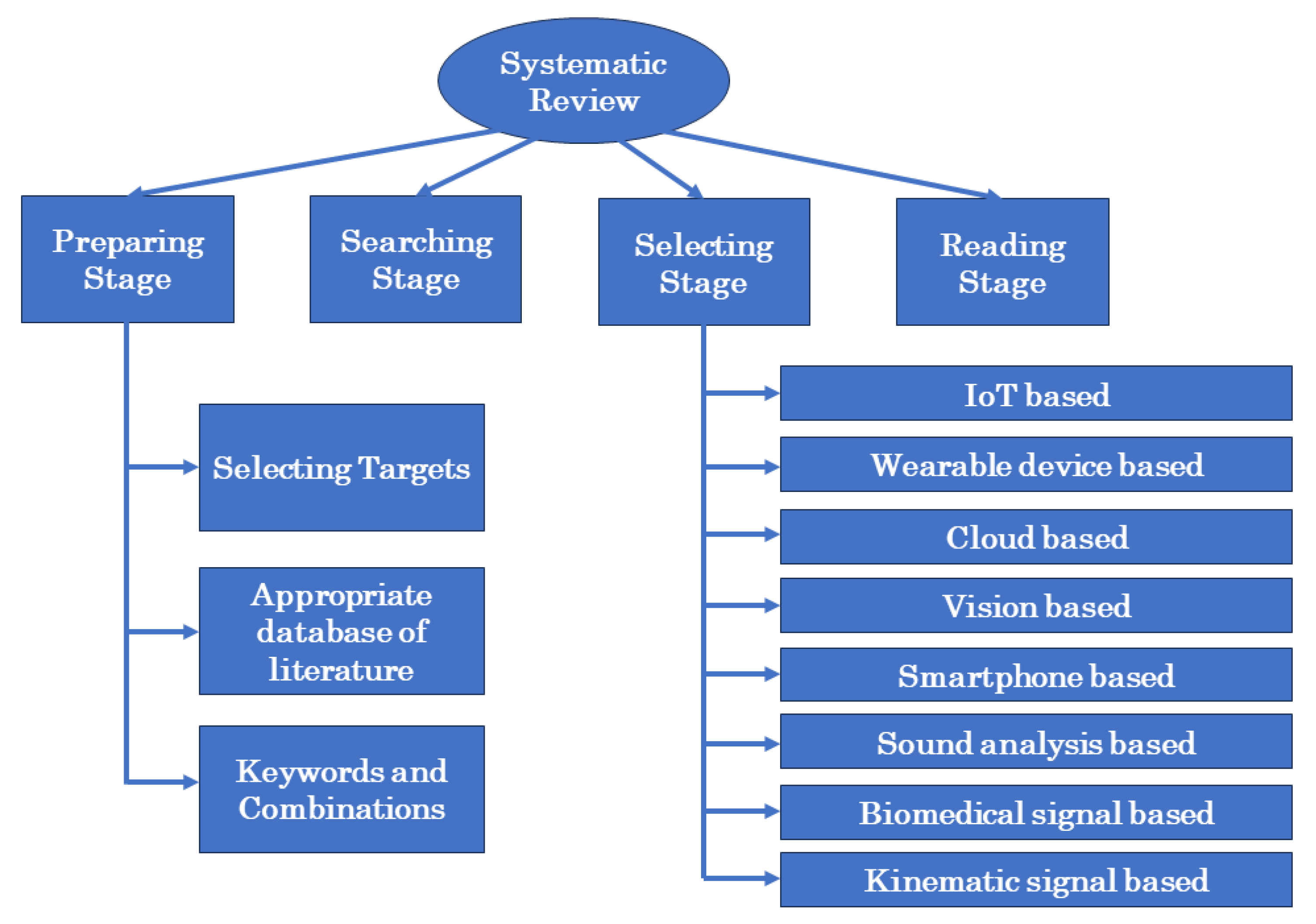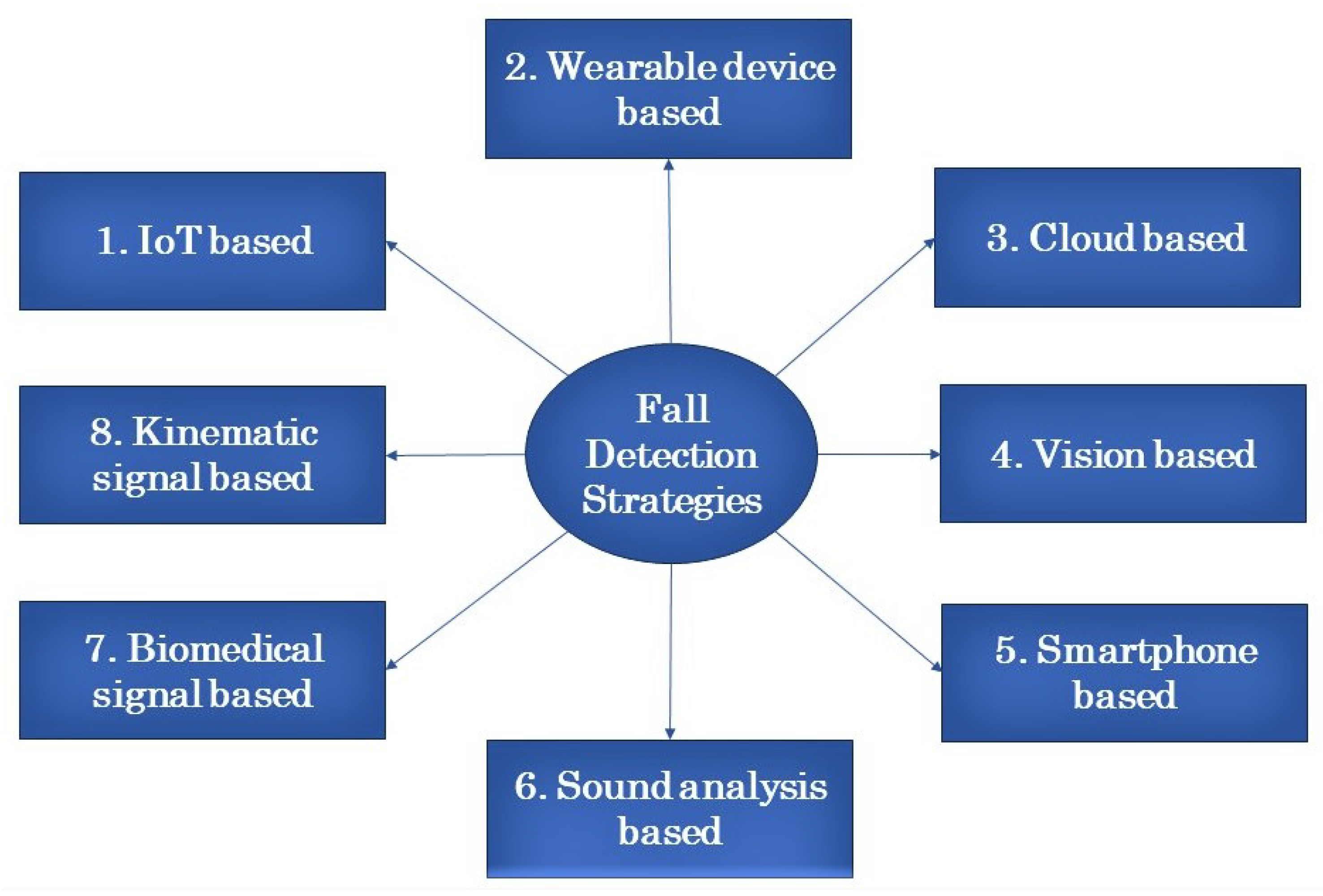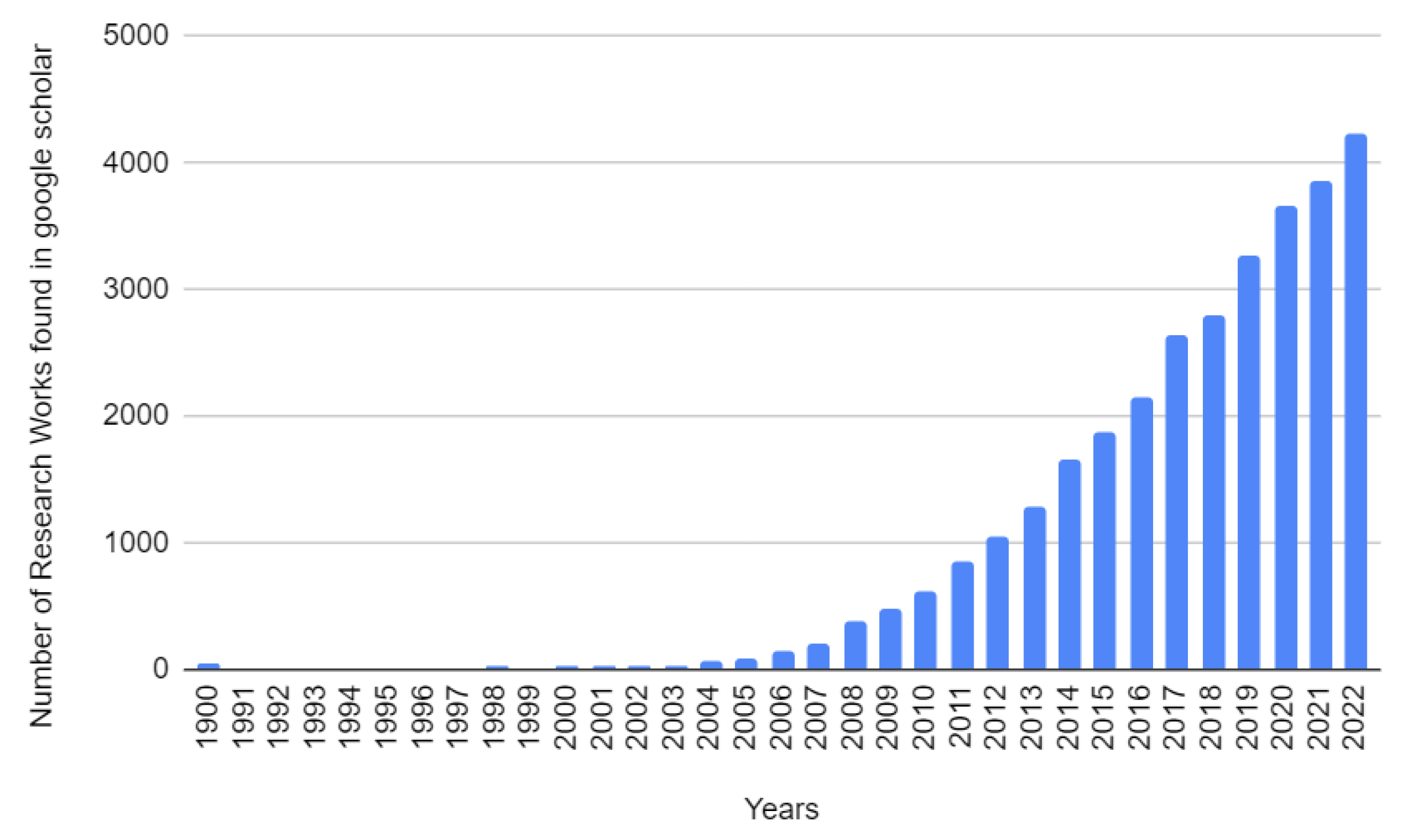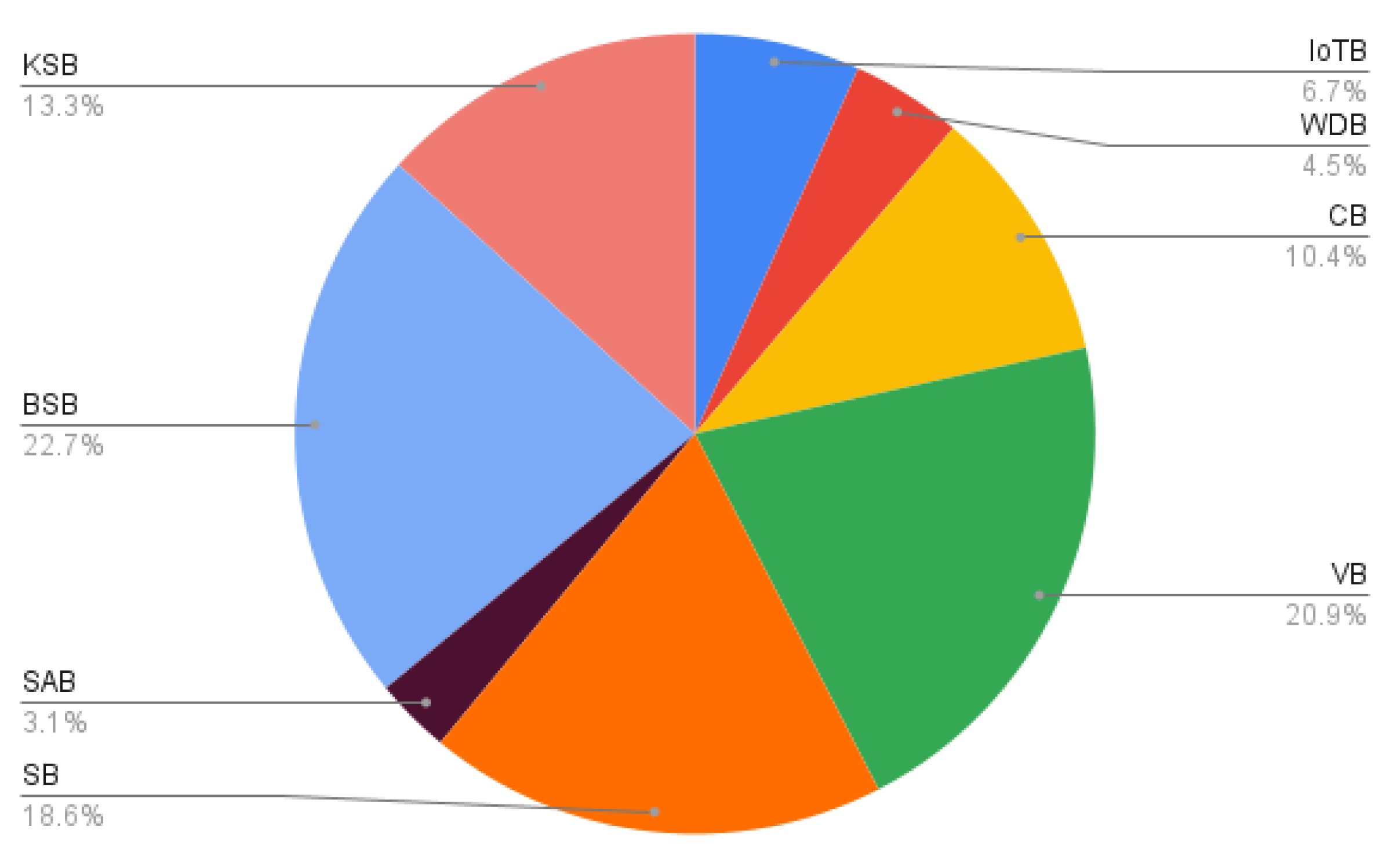The Methods of Fall Detection: A Literature Review
Abstract
1. Introduction
2. Methodology
- IoT-based.
- Wearable device-based.
- Cloud-based.
- Vision-based.
- Smartphone-based.
- Sound analysis-based.
- Biomedical signal-based.
- Kinematic signal-based.
3. Fall Detection Strategies
3.1. IoT-Based
3.2. Wearable Device Based
3.3. Cloud-Based
3.4. Vision-Based
3.5. Smartphone Based
3.6. Sound Analysis-Based
3.7. Biomedical-Based
3.8. Kinematic-Signal-Based
4. Datasets of Fall Detection
5. Discussions
5.1. Cloud Security of Fall Detection Approaches
5.2. Fall Detection for Older Persons
5.3. Fall Detection: The Past, Present, and Future
- IoT based (IoTB) = 6.682692308%
- Wearable device based (WDB) = 4.480769231%
- Cloud based (CB) = 10.38461538%
- Vision based (VB) = 20.86538462%
- Smartphone based (SB) = 18.55769231%
- Sound analysis based (SAB) = 3.067307692%
- Biomedical signal based (BSB) = 22.69230769%
- Kinematic signal based (KSB) = 13.26923077%
6. Conclusions
Author Contributions
Funding
Institutional Review Board Statement
Informed Consent Statement
Data Availability Statement
Conflicts of Interest
References
- Noury, N.; Fleury, A.; Rumeau, P.; Bourke, A.K.; Laighin, G.; Rialle, V.; Lundy, J.E. Fall detection-principles and methods. In Proceedings of the 2007 29th Annual International Conference of the IEEE Engineering in Medicine and Biology Society, Lyon, France, 22–26 August 2007; pp. 1663–1666. [Google Scholar]
- Mubashir, M.; Shao, L.; Seed, L. A survey on fall detection: Principles and approaches. Neurocomputing 2013, 100, 144–152. [Google Scholar] [CrossRef]
- Igual, R.; Medrano, C.; Plaza, I. Challenges, issues and trends in fall detection systems. Biomed. Eng. Online 2013, 12, 66. [Google Scholar] [CrossRef] [PubMed]
- Liu, H.; Xue, T.; Schultz, T. On a Real Real-Time Wearable Human Activity Recognition System. In Proceedings of the 16th International Joint Conference on Biomedical Engineering Systems and Technologies-WHC. INSTICC, SciTePress, Lisbon, Portugal, 16–18 February 2023; pp. 711–720. [Google Scholar] [CrossRef]
- Gia, T.N.; Sarker, V.K.; Tcarenko, I.; Rahmani, A.M.; Westerlund, T.; Liljeberg, P.; Tenhunen, H. Energy efficient wearable sensor node for IoT-based fall detection systems. Microprocess. Microsyst. 2018, 56, 34–46. [Google Scholar]
- Chatterjee, P.; Cymberknop, L.J.; Armentano, R.L. IoT-based decision support system for intelligent healthcare—applied to cardiovascular diseases. In Proceedings of the 2017 7th International Conference on Communication Systems and Network Technologies (CSNT), IEEE, Nagpur, India, 11–13 November 2017; pp. 362–366. [Google Scholar]
- Tzallas, A.T.; Tsipouras, M.G.; Rigas, G.; Tsalikakis, D.G.; Karvounis, E.C.; Chondrogiorgi, M.; Psomadellis, F.; Cancela, J.; Pastorino, M.; Waldmeyer, M.T.A.; et al. PERFORM: A system for monitoring, assessment and management of patients with Parkinson’s disease. Sensors 2014, 14, 21329–21357. [Google Scholar] [CrossRef] [PubMed]
- Pereira, C.; Macedo, P.; Madeira, R.N. Mobile Integrated Assistance to Empower People Coping with Parkinson’s Disease. In Proceedings of the 17th International ACM SIGACCESS Conference on Computers & Accessibility, Lisbon, Portugal, 26–28 October 2015; pp. 409–410. [Google Scholar]
- Wankhede, K.; Pednekar, S. Aid for ALS patient using ALS Specs and IOT. In Proceedings of the 2019 2nd International Conference on Intelligent Autonomous Systems (ICoIAS), IEEE, Singapore, 28 February–2 March 2019; pp. 146–149. [Google Scholar]
- Punin, C.; Barzallo, B.; Huerta, M.; Bermeo, A.; Bravo, M.; Llumiguano, C. Wireless devices to restart walking during an episode of FOG on patients with Parkinson’s disease. In Proceedings of the 2017 IEEE Second Ecuador Technical Chapters Meeting (ETCM), IEEE, Salinas, Ecuador, 16–20 October 2017; pp. 1–6. [Google Scholar]
- Pierleoni, P.; Belli, A.; Palma, L.; Pellegrini, M.; Pernini, L.; Valenti, S. A high reliability wearable device for elderly fall detection. IEEE Sensors J. 2015, 15, 4544–4553. [Google Scholar] [CrossRef]
- Baga, D.; Fotiadis, D.I.; Konitsiotis, S.; Tsouli, S.; Diakou, M.; Arrendondo, M.T.; Estrada, J.J.; Pansera, M.; Akay, M. PERFORM: A platform for monitoring and management of chronic neurodegenerative diseases: The Parkinson and Amyotrophic Lateral Sclerosis case. In Proceedings of the 2009 4th International IEEE/EMBS Conference on Neural Engineering, IEEE, Antalya, Turkey, 29 April–2 May 2009; pp. 1–5. [Google Scholar]
- Tan, Y.K.; Merrett, G. Wireless Sensor Networks: Application-Centric Design; IntechOpen: London, UK, 2010. [Google Scholar]
- Wang, Y.; Wu, K.; Ni, L.M. Wifall: Device-free fall detection by wireless networks. IEEE Trans. Mob. Comput. 2016, 16, 581–594. [Google Scholar] [CrossRef]
- LeMoyne, R.; Tomycz, N.; Mastroianni, T.; McCandless, C.; Cozza, M.; Peduto, D. Implementation of a smartphone wireless accelerometer platform for establishing deep brain stimulation treatment efficacy of essential tremor with machine learning. In Proceedings of the 2015 37th Annual International Conference of the IEEE Engineering in Medicine and Biology Society (EMBC), IEEE, Milan, Italy, 25–29 August 2015; pp. 6772–6775. [Google Scholar]
- Bustamante, P.; Solas, G.; Grandez, K. Wireless device for people affected by neurodegenerative diseases. In Proceedings of the 5th International Conference on Soft Computing as Transdisciplinary Science and Technology, Cergy-Pontoise, France, 28-31 October 2008; pp. 106–111. [Google Scholar]
- Tisch, U.; Schlesinger, I.; Ionescu, R.; Nassar, M.; Axelrod, N.; Robertman, D.; Tessler, Y.; Azar, F.; Marmur, A.; Aharon-Peretz, J.; et al. Detection of Alzheimer’s and Parkinson’s disease from exhaled breath using nanomaterial-based sensors. Nanomedicine 2013, 8, 43–56. [Google Scholar] [CrossRef]
- Theodoridis, T.; Solachidis, V.; Vretos, N.; Daras, P. Human fall detection from acceleration measurements using a recurrent neural network. In International Conference on Biomedical and Health Informatics; Springer: Berlin/Heidelberg, Germany, 2017; pp. 145–149. [Google Scholar]
- Pan, D.; Dhall, R.; Lieberman, A.; Petitti, D.B. A mobile cloud-based Parkinson’s disease assessment system for home-based monitoring. JMIR mHealth uHealth 2015, 3, e3956. [Google Scholar] [CrossRef]
- Alhussein, M. Monitoring Parkinson’s disease in smart cities. IEEE Access 2017, 5, 19835–19841. [Google Scholar] [CrossRef]
- Depari, A.; Fernandes Carvalho, D.; Bellagente, P.; Ferrari, P.; Sisinni, E.; Flammini, A.; Padovani, A. An IoT based architecture for enhancing the effectiveness of prototype medical instruments applied to neurodegenerative disease diagnosis. Sensors 2019, 19, 1564. [Google Scholar] [CrossRef]
- García-Magariño, I.; Varela-Aldas, J.; Palacios-Navarro, G.; Lloret, J. Fog computing for assisting and tracking elder patients with neurodegenerative diseases. Peer-Peer Netw. Appl. 2019, 12, 1225–1235. [Google Scholar] [CrossRef]
- Akhund, N.U.; Md, T.; Mahi, M.; Nayeen, J.; Hasnat Tanvir, A.; Mahmud, M.; Kaiser, M.S. ADEPTNESS: Alzheimer’s disease patient management system using pervasive sensors-early prototype and preliminary results. In International Conference on Brain Informatics; Springer: Berlin/Heidelberg, Germany, 2018; pp. 413–422. [Google Scholar]
- Hu, X.; Qu, X. Pre-impact fall detection. Biomed. Eng. Online 2016, 15, 1–16. [Google Scholar] [CrossRef] [PubMed]
- Newaz, N.T.; Haque, M.R.; Akhund, T.M.N.U.; Khatun, T.; Biswas, M.; Yousuf, M.A. Iot security perspectives and probable solution. In Proceedings of the 2021 Fifth World Conference on Smart Trends in Systems Security and Sustainability (WorldS4), IEEE, London, UK, 29–30 July 2021; pp. 81–86. [Google Scholar]
- Kamarol, S.K.A.; Jaward, M.H.; Parkkinen, J.; Parthiban, R. Spatiotemporal feature extraction for facial expression recognition. IET Image Process. 2016, 10, 534–541. [Google Scholar] [CrossRef]
- Xie, L.; Wei, H.; Yang, W.; Zhang, K. Video-based facial expression recognition using histogram sequence of local gabor binary patterns from three orthogonal planes. In Proceedings of the 33rd Chinese Control Conference, Nanjing, China, 28–30 July 2014; pp. 4772–4776. [Google Scholar]
- Suja, P.; Tripathi, S. Dynamic facial emotion recognition from 4D video sequences. In Proceedings of the 2015 Eighth International Conference on Contemporary Computing (IC3), IEEE, Washington, DC, USA, 20–22 August 2015; pp. 348–353. [Google Scholar]
- Chiranjeevi, P.; Gopalakrishnan, V.; Moogi, P. Neutral face classification using personalized appearance models for fast and robust emotion detection. IEEE Trans. Image Process. 2015, 24, 2701–2711. [Google Scholar] [CrossRef]
- Shojaeilangari, S.; Yau, W.Y.; Nandakumar, K.; Li, J.; Teoh, E.K. Robust representation and recognition of facial emotions using extreme sparse learning. IEEE Trans. Image Process. 2015, 24, 2140–2152. [Google Scholar] [CrossRef] [PubMed]
- Maitre, J.; Bouchard, K.; Gaboury, S. Fall detection with UWB radars and CNN-LSTM architecture. IEEE J. Biomed. Health Inform. 2020, 25, 1273–1283. [Google Scholar] [CrossRef] [PubMed]
- Ali, S.F.; Khan, R.; Mahmood, A.; Hassan, M.T.; Jeon, M. Using temporal covariance of motion and geometric features via boosting for human fall detection. Sensors 2018, 18, 1918. [Google Scholar] [CrossRef] [PubMed]
- Núñez-Marcos, A.; Azkune, G.; Arganda-Carreras, I. Vision-based fall detection with convolutional neural networks. Wirel. Commun. Mob. Comput. 2017, 2017, 9474806. [Google Scholar] [CrossRef]
- Zerrouki, N.; Houacine, A. Combined curvelets and hidden Markov models for human fall detection. Multimed. Tools Appl. 2018, 77, 6405–6424. [Google Scholar] [CrossRef]
- Liu, C.L.; Lee, C.H.; Lin, P.M. A fall detection system using k-nearest neighbor classifier. Expert Syst. Appl. 2010, 37, 7174–7181. [Google Scholar] [CrossRef]
- Sase, P.S.; Bhandari, S.H. Human fall detection using depth videos. In Proceedings of the 2018 5th International Conference on Signal Processing and Integrated Networks (SPIN), Noida, Delhi, 22–23 February 2018; pp. 546–549. [Google Scholar]
- Keskes, O.; Noumeir, R. Vision-based fall detection using st-gcn. IEEE Access 2021, 9, 28224–28236. [Google Scholar] [CrossRef]
- Rougier, C.; Meunier, J.; St-Arnaud, A.; Rousseau, J. Fall detection from human shape and motion history using video surveillance. In Proceedings of the 21st International Conference on Advanced Information Networking and Applications Workshops (AINAW’07), Niagara Falls, ON, Canada, 21–23 May 2007; Volume 2, pp. 875–880. [Google Scholar]
- De Miguel, K.; Brunete, A.; Hernando, M.; Gambao, E. Home camera-based fall detection system for the elderly. Sensors 2017, 17, 2864. [Google Scholar] [CrossRef]
- Foroughi, H.; Aski, B.S.; Pourreza, H. Intelligent video surveillance for monitoring fall detection of elderly in home environments. In Proceedings of the 2008 11th International Conference on Computer and Information Technology, Sydney, Australia, 8–11 July 2008; pp. 219–224. [Google Scholar]
- Galvão, Y.M.; Ferreira, J.; Albuquerque, V.A.; Barros, P.; Fernandes, B.J. A multimodal approach 617 using deep learning for fall detection. Expert Syst. Appl. 2021, 168, 114226. [Google Scholar] [CrossRef]
- Mostarac, P.; Malarić, R.; Jurčević, M.; Hegeduš, H.; Lay-Ekuakille, A.; Vergallo, P. System for monitoring and fall detection of patients using mobile 3-axis accelerometers sensors. In Proceedings of the 2011 IEEE International Symposium on Medical Measurements and Applications, Bari, Italy, 30–31 May 2011; pp. 456–459. [Google Scholar]
- Fang, S.H.; Liang, Y.C.; Chiu, K.M. Developing a mobile phone-based fall detection system on android platform. In Proceedings of the 2012 Computing, Communications and Applications Conference, Hong Kong, China, 11–13 January 2012; pp. 143–146. [Google Scholar]
- Stone, E.E.; Skubic, M. Fall detection in homes of older adults using the Microsoft Kinect. IEEE J. Biomed. Health Inform. 2014, 19, 290–301. [Google Scholar] [CrossRef] [PubMed]
- Dai, J.; Bai, X.; Yang, Z.; Shen, Z.; Xuan, D. Mobile phone-based pervasive fall detection. Pers. Ubiquitous Comput. 2010, 14, 633–643. [Google Scholar] [CrossRef]
- Vallabh, P.; Malekian, R.; Ye, N.; Bogatinoska, D.C. Fall detection using machine learning algorithms. In Proceedings of the 2016 24th International Conference on Software, Telecommunications and Computer Networks (SoftCOM), Split, Croatia, 22–24 September 2016; pp. 1–9. [Google Scholar]
- Al Mamun, K.A.; Alhussein, M.; Sailunaz, K.; Islam, M.S. Cloud based framework for Parkinson’s disease diagnosis and monitoring system for remote healthcare applications. Future Gener. Comput. Syst. 2017, 66, 36–47. [Google Scholar] [CrossRef]
- Doukas, C.; Maglogiannis, I. Advanced patient or elder fall detection based on movement and sound data. In Proceedings of the 2008 Second International Conference on Pervasive Computing Technologies for Healthcare, Tampere, Finland, 29 January–1 February 2008; pp. 103–107. [Google Scholar]
- Pham, M.; Mengistu, Y.; Do, H.M.; Sheng, W. Cloud-based smart home environment (CoSHE) for home healthcare. In Proceedings of the 2016 IEEE International Conference on Automation Science and Engineering (CASE), Fort Worth, TX, USA, 21–25 August 2016; pp. 483–488. [Google Scholar]
- Principi, E.; Squartini, S.; Bonfigli, R.; Ferroni, G.; Piazza, F. An integrated system for voice command recognition and emergency detection based on audio signals. Expert Syst. Appl. 2015, 42, 5668–5683. [Google Scholar] [CrossRef]
- Kaur, P.; Wang, Q.; Shi, W. Fall detection from audios with audio transformers. Smart Health 2022, 26, 100340. [Google Scholar] [CrossRef]
- Hassan, F.; Mehmood, M.H.; Younis, B.; Mehmood, N.; Imran, T.; Zafar, U. Comparative Analysis of Machine Learning Algorithms for Classification of Environmental Sounds and Fall Detection. Sci. Technol. 2022, 4, 163–174. [Google Scholar] [CrossRef]
- NAGANUMA, K.; OKUSA, K. A Study on the Model Based Fall Detection System using Microwave Doppler Radar. Comput. Stat. 2017, 30, 17–30. [Google Scholar]
- Thome, N.; Miguet, S.; Ambellouis, S. A real-time, multiview fall detection system: A LHMM-based approach. IEEE Trans. Circuits Syst. Video Technol. 2008, 18, 1522–1532. [Google Scholar] [CrossRef]
- Hwang, J.Y.; Kang, J.; Jang, Y.W.; Kim, H.C. Development of novel algorithm and real-time monitoring ambulatory system using Bluetooth module for fall detection in the elderly. In Proceedings of the The 26th Annual International Conference of the IEEE Engineering in Medicine and Biology Society, San Francisco, CA, USA, 1–5 September 2004; Volume 1, pp. 2204–2207. [Google Scholar]
- Butt, F.S.; La Blunda, L.; Wagner, M.F.; Schäfer, J.; Medina-Bulo, I.; Gómez-Ullate, D. Fall detection from electrocardiogram (ecg) signals and classification by deep transfer learning. Information 2021, 12, 63. [Google Scholar] [CrossRef]
- Chou, H.C.; Han, K.Y. Developing a smart walking cane with remote electrocardiogram and fall detection. J. Intell. Fuzzy Syst. 2021, 40, 8073–8086. [Google Scholar] [CrossRef]
- Xue, T.; Liu, H. Hidden Markov Model and its application in human activity recognition and fall detection: A review. In Proceedings of the 10th International Conference on Communications, Signal Processing, and Systems, Online, 23–24 July 2022; Springer: Berlin/Heidelberg, Germany, 2022; Volume 1, pp. 863–869. [Google Scholar]
- Liu, H.; Schultz, I.T. Biosignal Processing and Activity Modeling for Multimodal Human Activity Recognition. Ph.D Thesis, Universität Bremen, Bremen, Germany, 2021. [Google Scholar]
- Liu, H.; Hartmann, Y.; Schultz, T. Motion Units: Generalized Sequence Modeling of Human Activities for Sensor-Based Activity Recognition. In Proceedings of the 2021 29th European Signal Processing Conference (EUSIPCO), Dublin, Ireland, 23–27 August 2021; pp. 1506–1510. [Google Scholar] [CrossRef]
- Wu, F.; Zhao, H.; Zhao, Y.; Zhong, H. Development of a wearable-sensor-based fall detection system. Int. J. Telemed. Appl. 2015, 2015, 576364. [Google Scholar] [CrossRef] [PubMed]
- Kwolek, B.; Kepski, M. Improving fall detection by the use of depth sensor and accelerometer. Neurocomputing 2015, 168, 637–645. [Google Scholar] [CrossRef]
- Bourke, A.K.; Lyons, G.M. A threshold-based fall-detection algorithm using a bi-axial gyroscope sensor. Med. Eng. Phys. 2008, 30, 84–90. [Google Scholar] [CrossRef]
- Li, Q.; Stankovic, J.A.; Hanson, M.A.; Barth, A.T.; Lach, J.; Zhou, G. Accurate, fast fall detection using gyroscopes and accelerometer-derived posture information. In Proceedings of the 2009 Sixth International Workshop on Wearable and Implantable Body Sensor Networks, Berkeley, CA, USA, 3–5 June 2009; pp. 138–143. [Google Scholar]
- Kangas, M.; Konttila, A.; Winblad, I.; Jamsa, T. Determination of simple thresholds for accelerometry-based parameters for fall detection. In Proceedings of the 2007 29th Annual International Conference of the IEEE Engineering in Medicine and Biology Society, Lyon, France, 22–26 August 2007; pp. 1367–1370. [Google Scholar]
- Chen, W.; Jiang, Z.; Guo, H.; Ni, X. Fall detection based on key points of human-skeleton using openpose. Symmetry 2020, 12, 744. [Google Scholar] [CrossRef]
- Espinosa, R.; Ponce, H.; Gutiérrez, S.; Martínez-Villaseñor, L.; Brieva, J.; Moya-Albor, E. A vision-based approach for fall detection using multiple cameras and convolutional neural networks: A case study using the UP-Fall detection dataset. Comput. Biol. Med. 2019, 115, 103520. [Google Scholar] [CrossRef] [PubMed]
- Igual, R.; Medrano, C.; Plaza, I. A comparison of public datasets for acceleration-based fall detection. Med. Eng. Phys. 2015, 37, 870–878. [Google Scholar] [CrossRef]
- Casilari, E.; Santoyo-Ramón, J.A.; Cano-García, J.M. Umafall: A multisensor dataset for the research on automatic fall detection. Procedia Comput. Sci. 2017, 110, 32–39. [Google Scholar] [CrossRef]
- Vavoulas, G.; Pediaditis, M.; Spanakis, E.G.; Tsiknakis, M. The MobiFall dataset: An initial evaluation of fall detection algorithms using smartphones. In Proceedings of the 13th IEEE International Conference on BioInformatics and BioEngineering, Chania, Greece, 10–13 November 2013; pp. 1–4. [Google Scholar]
- Martínez-Villaseñor, L.; Ponce, H.; Brieva, J.; Moya-Albor, E.; Núñez-Martínez, J.; Peñafort-Asturiano, C. UP-fall detection dataset: A multimodal approach. Sensors 2019, 19, 1988. [Google Scholar] [CrossRef] [PubMed]
- Micucci, D.; Mobilio, M.; Napoletano, P. Unimib shar: A dataset for human activity recognition using acceleration data from smartphones. Appl. Sci. 2017, 7, 1101. [Google Scholar] [CrossRef]
- Khan, F.A.; Ali, A.; Abbas, H.; Haldar, N.A.H. A cloud-based healthcare framework for security and patients’ data privacy using wireless body area networks. Procedia Comput. Sci. 2014, 34, 511–517. [Google Scholar] [CrossRef]
- Chen, M.; Qian, Y.; Chen, J.; Hwang, K.; Mao, S.; Hu, L. Privacy protection and intrusion avoidance for cloudlet-based medical data sharing. IEEE Trans. Cloud Comput. 2016, 9, 10771–10779. [Google Scholar] [CrossRef]
- Al Hamid, H.A.; Rahman, S.M.M.; Hossain, M.S.; Almogren, A.; Alamri, A. A security model for preserving the privacy of medical big data in a healthcare cloud using a fog computing facility with pairing-based cryptography. IEEE Access 2017, 5, 22313–22328. [Google Scholar] [CrossRef]
- Kliem, A.; Kao, O. Cosemed-cooperative and secure medical device cloud. In Proceedings of the 2013 IEEE 15th International Conference on e-Health Networking, Applications and Services (Healthcom 2013), Lisbon, Portugal, 9–12 October 2013; pp. 260–264. [Google Scholar]
- Jónsdóttir, H.L.; Ruthig, J.C. A longitudinal study of the negative impact of falls on health, well-being, and survival in later life: The protective role of perceived control. Aging Ment. Health 2021, 25, 742–748. [Google Scholar] [CrossRef] [PubMed]
- Taramasco, C.; Rodenas, T.; Martinez, F.; Fuentes, P.; Munoz, R.; Olivares, R.; De Albuquerque, V.H.C.; Demongeot, J. A novel monitoring system for fall detection in older people. IEEE Access 2018, 6, 43563–43574. [Google Scholar] [CrossRef]
- Nahiduzzaman, M.; Tasnim, M.; Newaz, N.T.; Kaiser, M.S.; Mahmud, M. Machine learning based early fall detection for elderly people with neurological disorder using multimodal data fusion. In Proceedings of the Brain Informatics: 13th International Conference, BI 2020, Proceedings 13, Padua, Italy, 19 September 2020; Springer: Berlin/Heidelberg, Germany, 2020; pp. 204–214. [Google Scholar]
- Santiago, J.; Cotto, E.; Jaimes, L.G.; Vergara-Laurens, I. Fall detection system for the elderly. In Proceedings of the 2017 IEEE 7th Annual Computing and Communication Workshop and Conference (CCWC), Las Vegas, NV, USA, 9–11 January 2017; pp. 1–4. [Google Scholar]
- Bian, Z.P.; Hou, J.; Chau, L.P.; Magnenat-Thalmann, N. Fall detection based on body part tracking using a depth camera. IEEE J. Biomed. Health Inform. 2014, 19, 430–439. [Google Scholar] [CrossRef]
- Marumo, S.; Higuchi, Y.; Kim, M. A Study on Fall Detection Algorithms for Elderly People Using Triaxial Accelerometers. J. Environ. Eng. Archit. Inst. Jpn. 2018, 83, 913–920. [Google Scholar]




Disclaimer/Publisher’s Note: The statements, opinions and data contained in all publications are solely those of the individual author(s) and contributor(s) and not of MDPI and/or the editor(s). MDPI and/or the editor(s) disclaim responsibility for any injury to people or property resulting from any ideas, methods, instructions or products referred to in the content. |
© 2023 by the authors. Licensee MDPI, Basel, Switzerland. This article is an open access article distributed under the terms and conditions of the Creative Commons Attribution (CC BY) license (https://creativecommons.org/licenses/by/4.0/).
Share and Cite
Newaz, N.T.; Hanada, E. The Methods of Fall Detection: A Literature Review. Sensors 2023, 23, 5212. https://doi.org/10.3390/s23115212
Newaz NT, Hanada E. The Methods of Fall Detection: A Literature Review. Sensors. 2023; 23(11):5212. https://doi.org/10.3390/s23115212
Chicago/Turabian StyleNewaz, Nishat Tasnim, and Eisuke Hanada. 2023. "The Methods of Fall Detection: A Literature Review" Sensors 23, no. 11: 5212. https://doi.org/10.3390/s23115212
APA StyleNewaz, N. T., & Hanada, E. (2023). The Methods of Fall Detection: A Literature Review. Sensors, 23(11), 5212. https://doi.org/10.3390/s23115212





